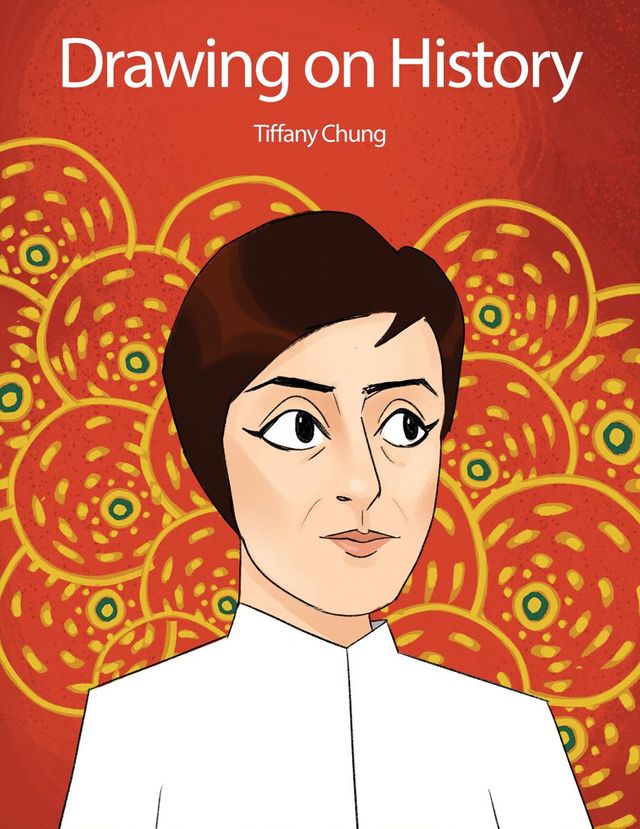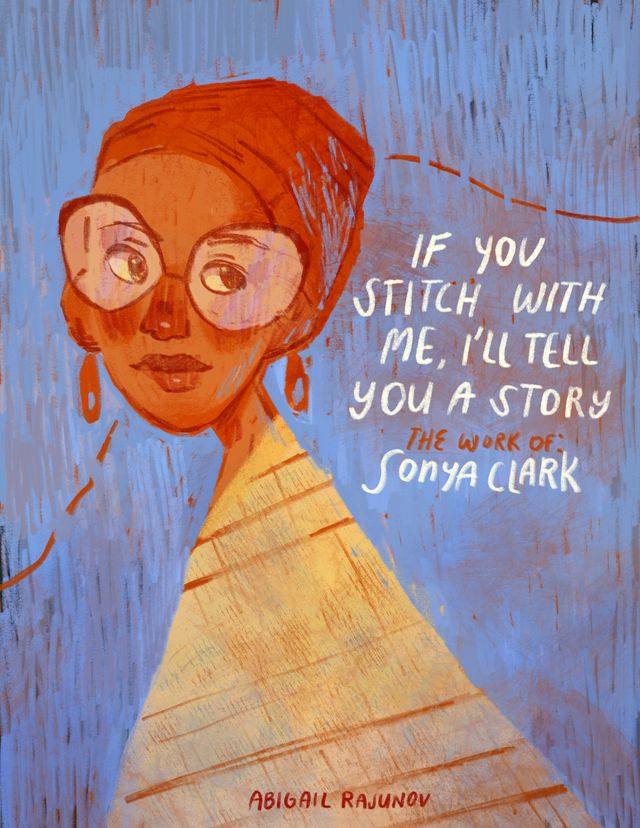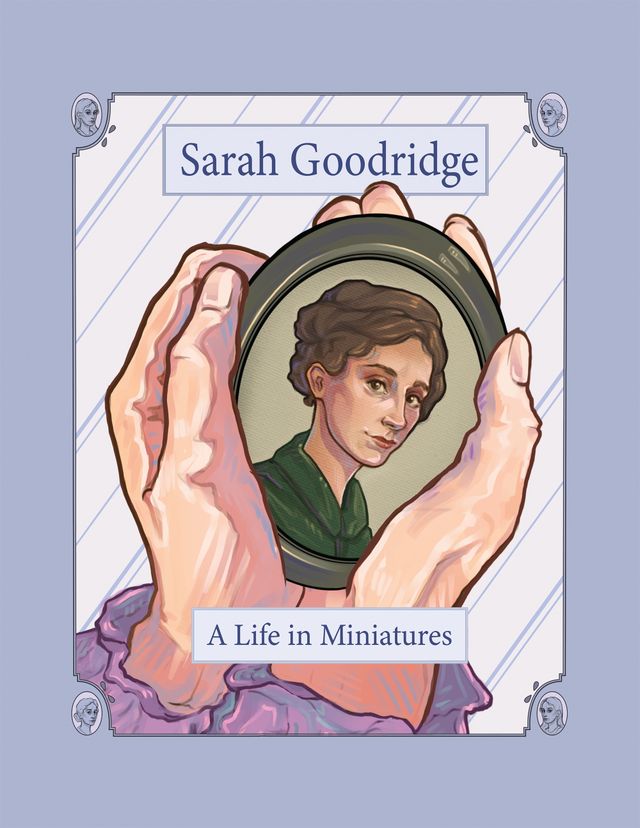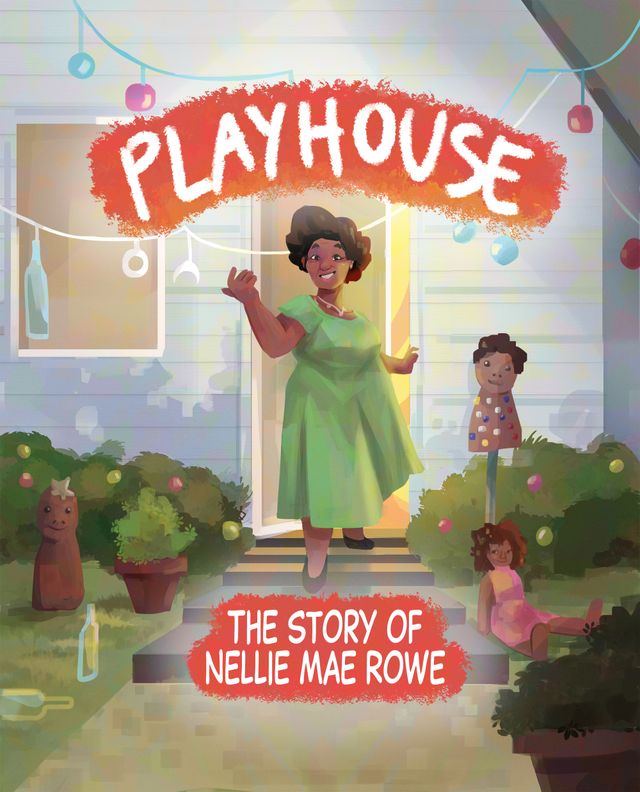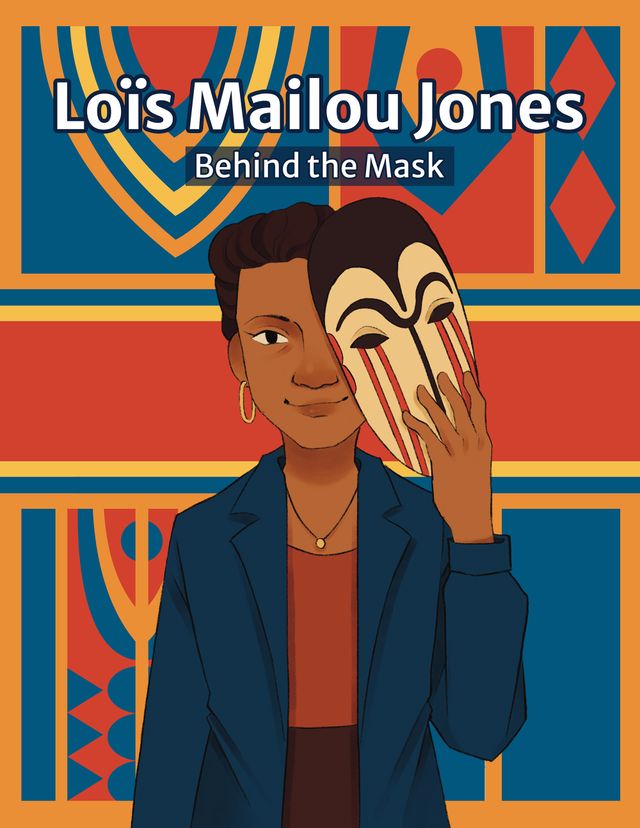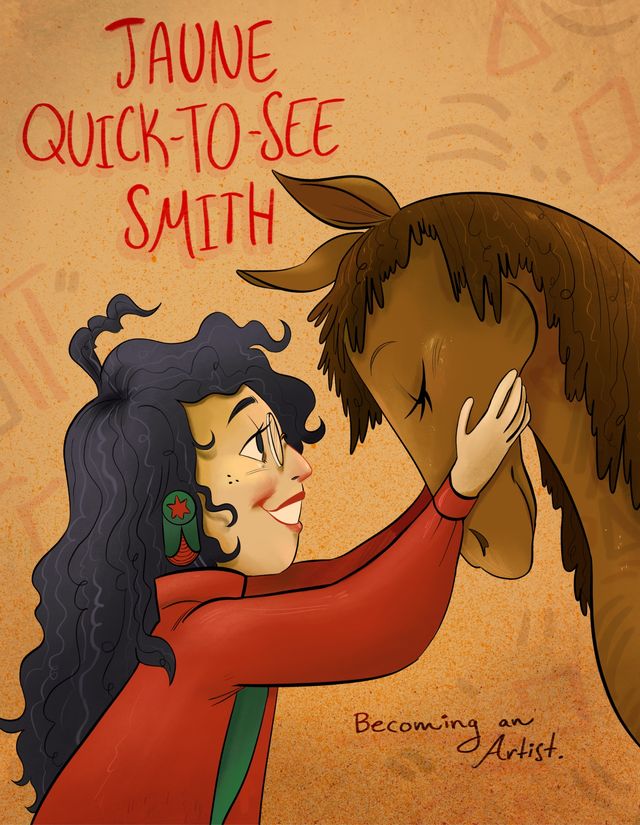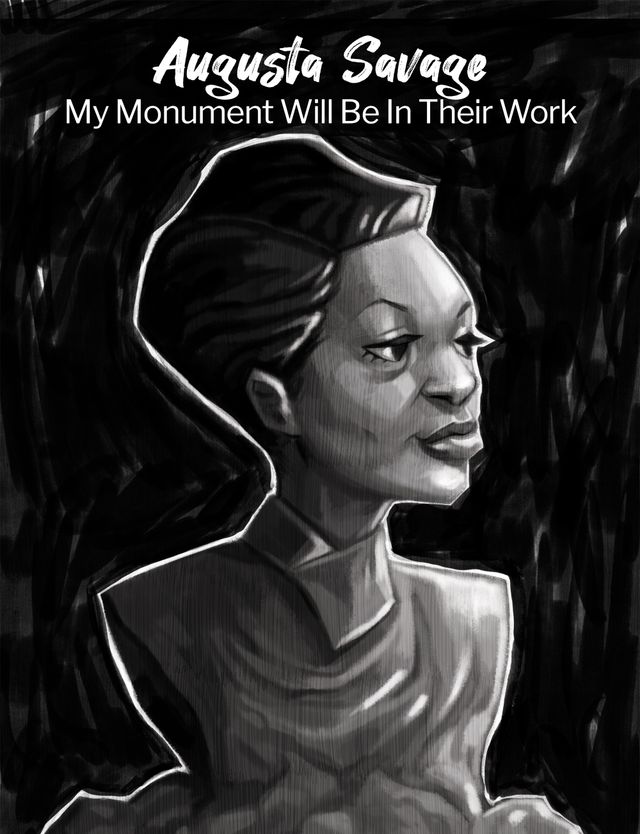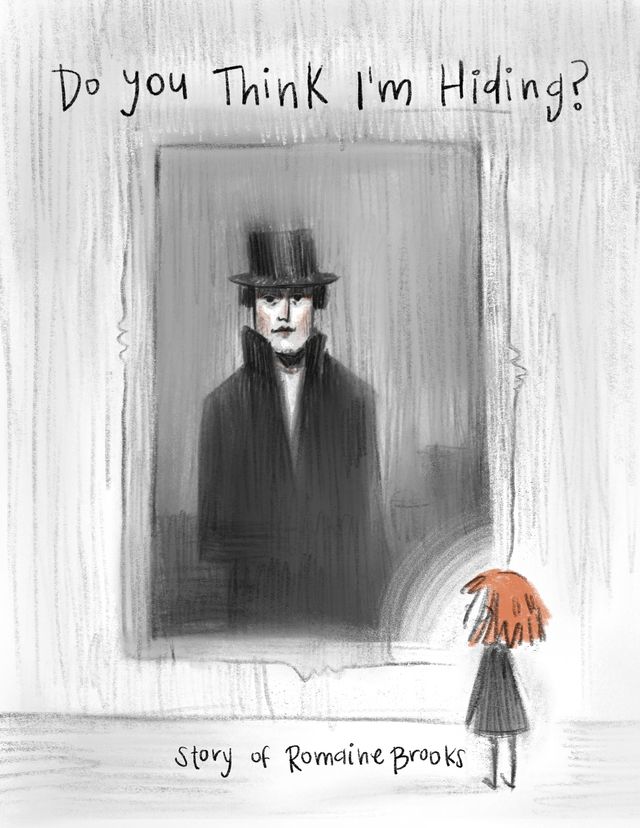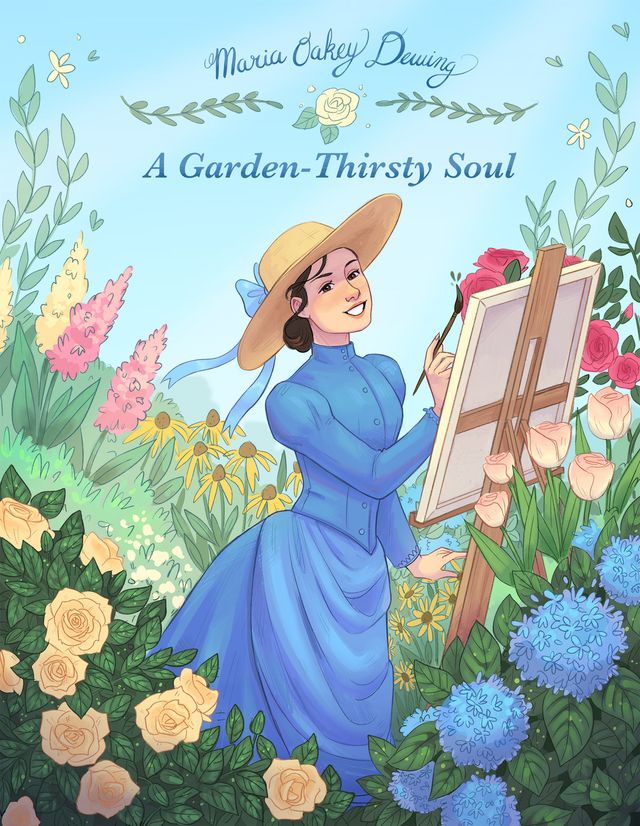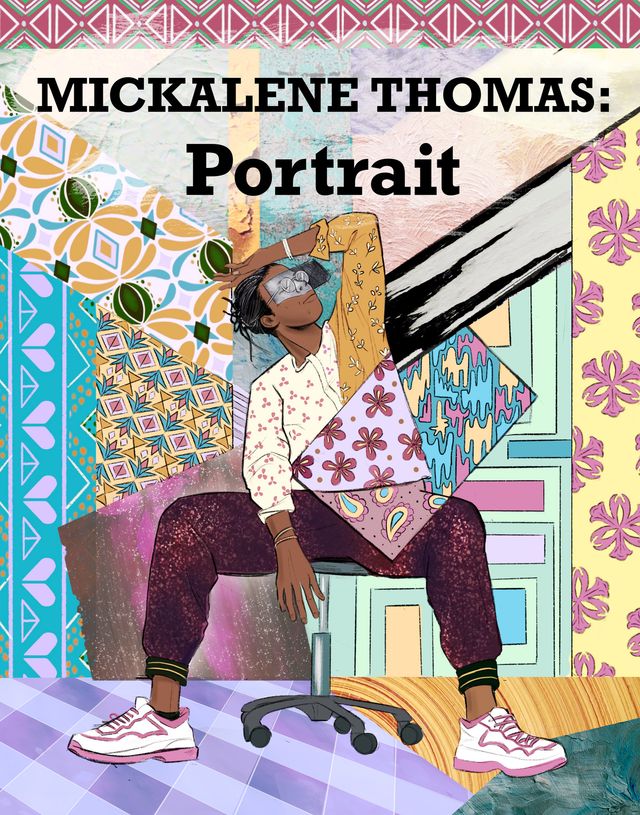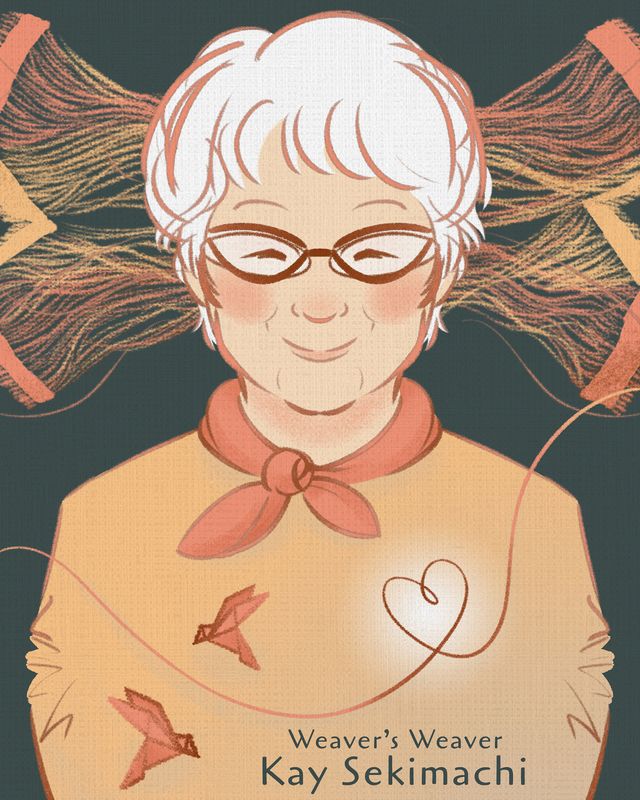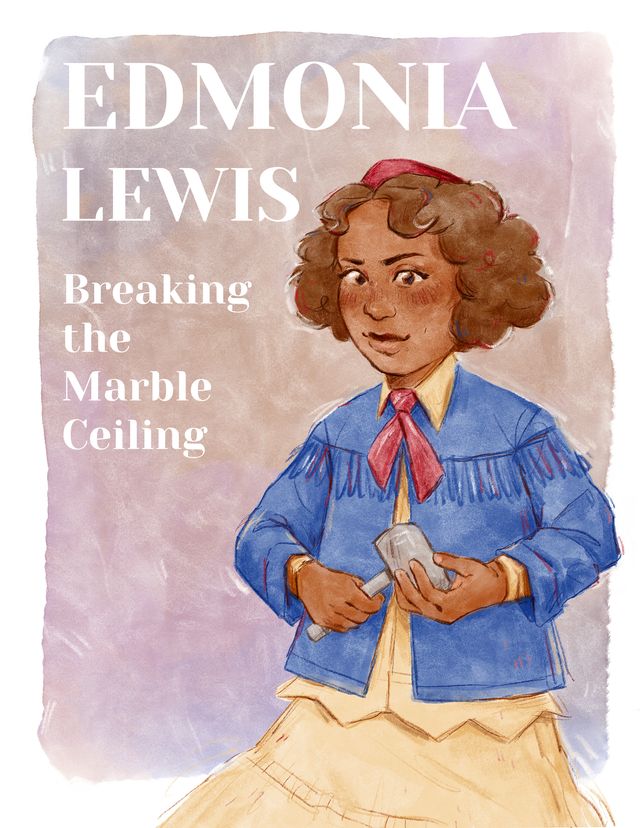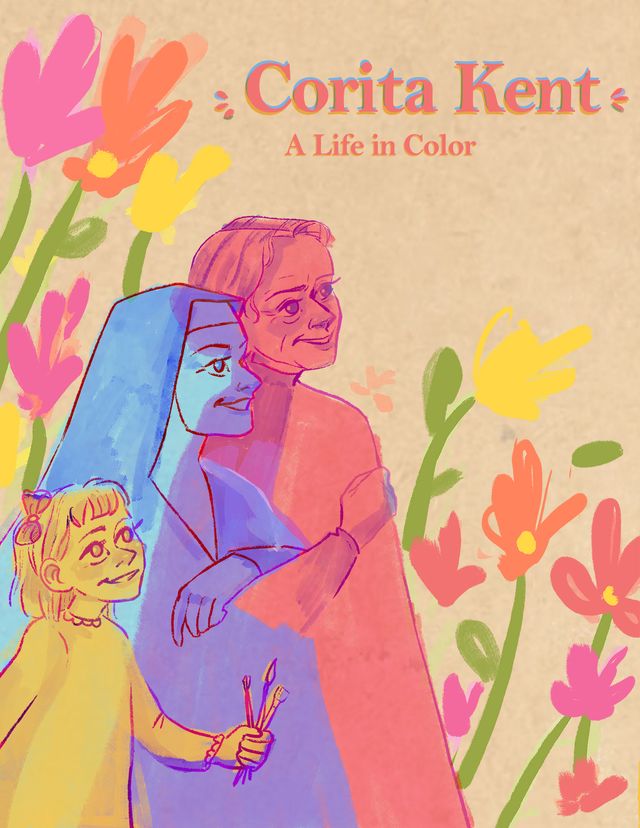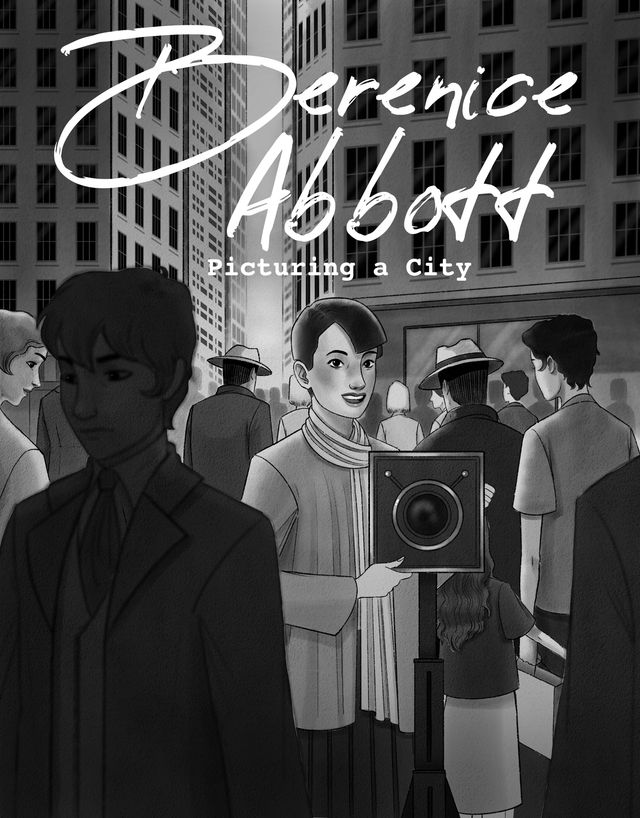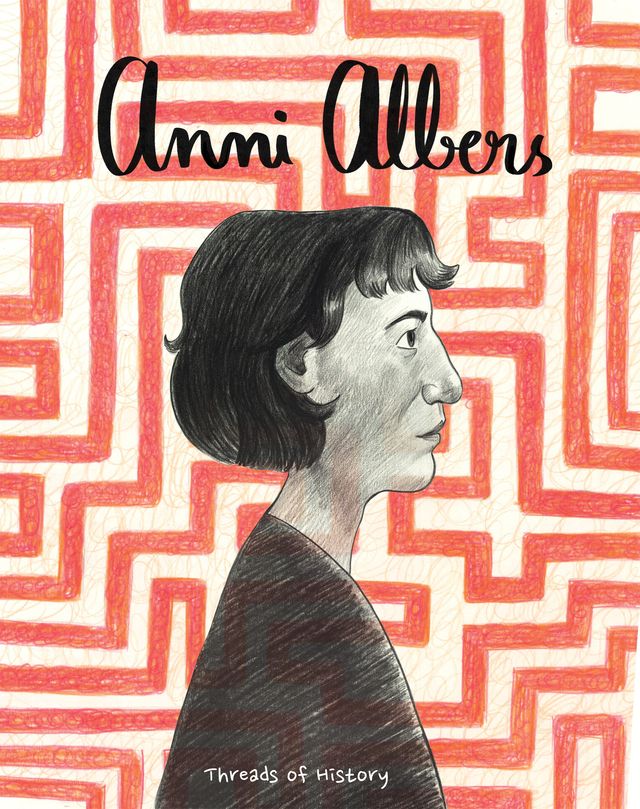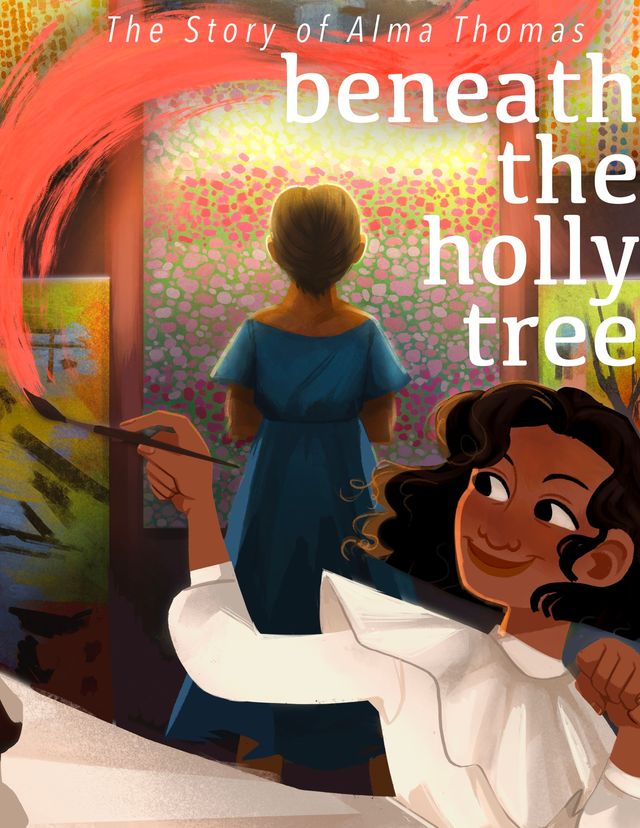An Overview
As someone who challenged accepted standards of beauty and represented the queer community, Laura Aguilar is one of the most influential Chicana photographers of her generation.
This comic is part of a series Drawn to Art: Tales of Inspiring Women Artists that illuminates the stories of women artists in the collection of the Smithsonian American Art Museum. Inspired by graphic novels, these short takes on artists’ lives were each drawn by a student-illustrator from the Ringling College of Art and Design.
We invite you to read the comic and share it with your friends and young people in your life.
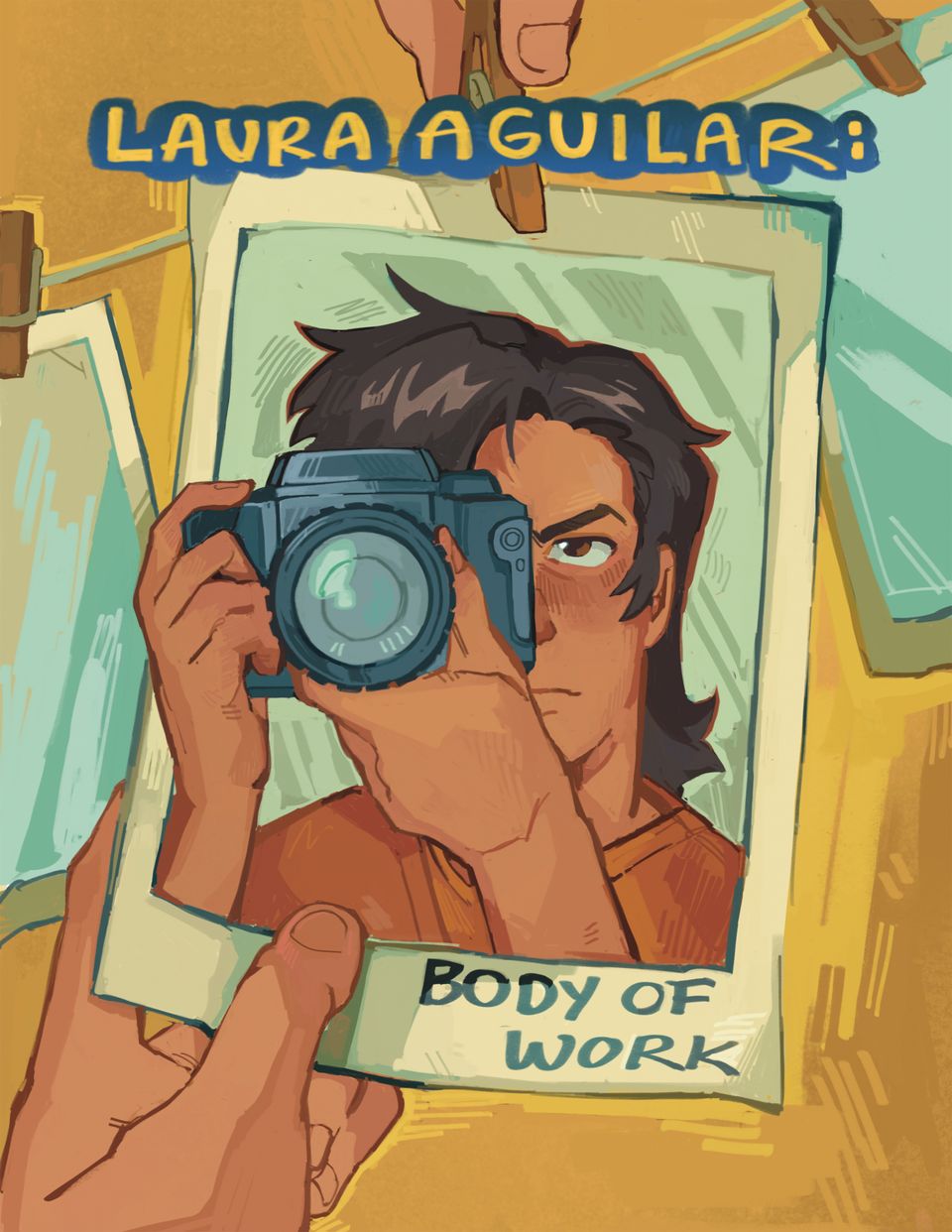
Cover of the comic "Laura Aguilar: Body of Work." Illustration by Tyler Tjaden
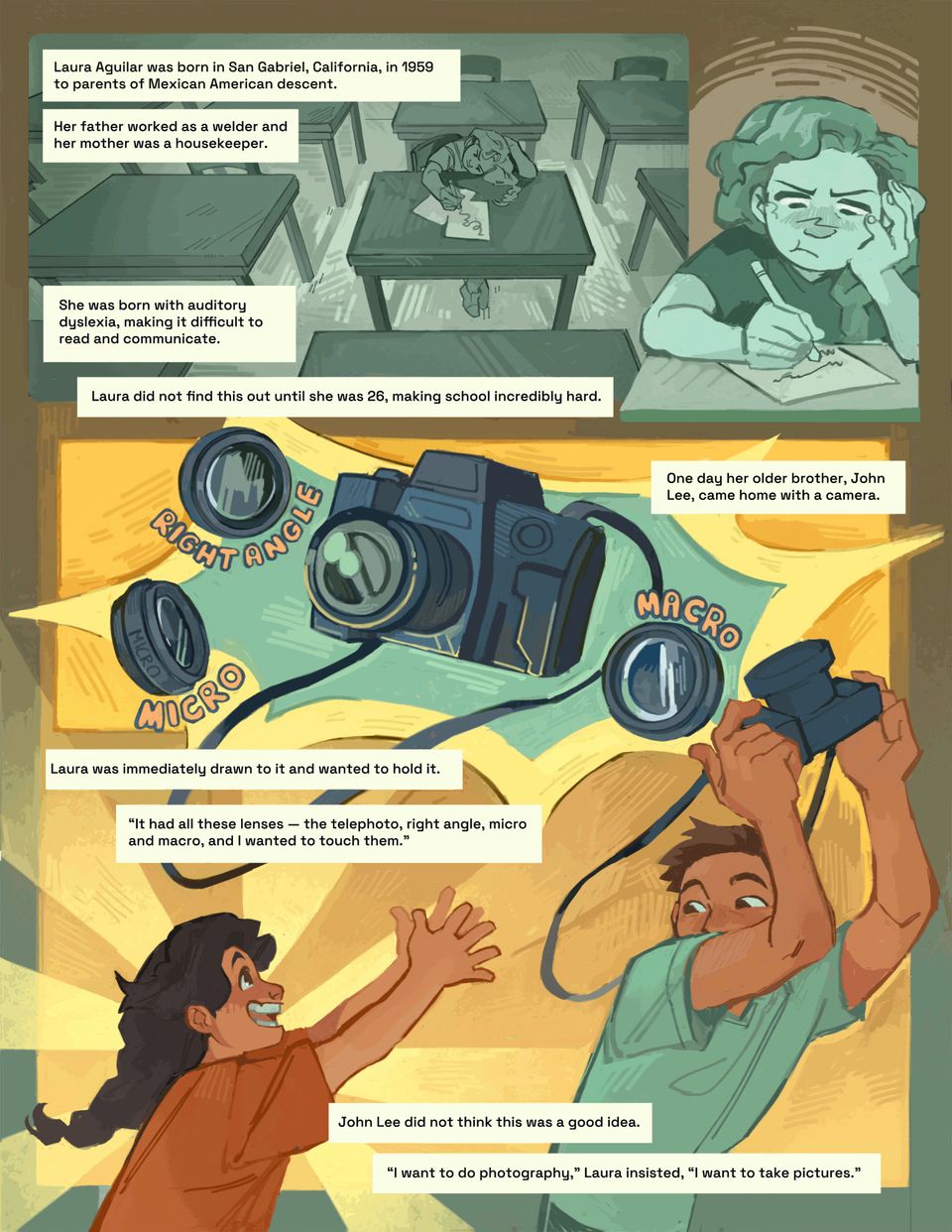
Page 1
Background: This page is broken into three scenes, one in the upper third, one in the center, and one at the bottom of the page. Behind the panels is a gradient background going from army green at the top to a dark teal at the bottom. There are nine light green textboxes with black text.
Panel 1
There is an illustration of a young girl sitting at a desk in the middle of an empty classroom. There are empty desks surrounding her as she leans her head against the table where she sits. She is drawing with her right hand on two blank pieces of paper. The scene is monochrome shades of blue-green. Text in the two text boxes at the top of the page read: "Laura Aguilar was born in San Gabriel, California, in 1959 to parents of Mexican American descent. Her father worked as a welder and her mother as a housekeeper." At the bottom of the panel in two text boxes, text reads: "She was born with auditory dyslexia, making it difficult to read and communicate. Laura did not find this out until she was 26, making school incredibly hard."
To the right of the panel is a close-up of a young Laura, frustrated and angry, staring down at a piece of paper. She is leaning her head on her left arm propped on the desk in front of her. She writes with her right hand on the piece of paper on her desk. She has short curly hair and is wearing a dark t-shirt. This illustration is also monochrome shades of blue-green. A light brown halo sits over her head.
Panel 2
A black film camera sits in the center of the panel on top of a splash of light blue-green that is outlined in bright yellow. The points of this splash of color stick out of the sides of the panel. The camera lens is facing to the left of the page and is surrounded by different lenses. In the top left there is a right-angle lens, in the bottom left there is a micro lens, and in the bottom right is a macro lens. Handwritten orange text written under each lens states the name of the lens. Text in the upper right corner reads: "One day her older brother, John Lee, came home with a camera." Text in the lower left corner reads: "Laura was immediately drawn to it and wanted to hold it. 'It had all these lenses, the telephoto, right angle, micro and macro, and I wanted to touch them.'"
Panel 3
A young version of Laura stands in the bottom left corner reaching her hands up towards her older brother, who is holding the camera above his head out of reach. Laura has a medium skin tone and has long curly brown hair braided behind her. She is wearing a burnt orange t-shirt and is smiling at her brother. John Lee has a medium skin tone and short medium brown hair. He is wearing a light teal T-shirt and has both of his arms bent, holding the black film camera above his head, as far from Laura as possible. Behind them is a mustard yellow background, and around Laura beams of bright yellow light emerge, fading into the mustard background. Text reads: "John Lee did not think this was a good idea. 'I want to do photography.' Laura insisted, 'I want to take pictures.'"
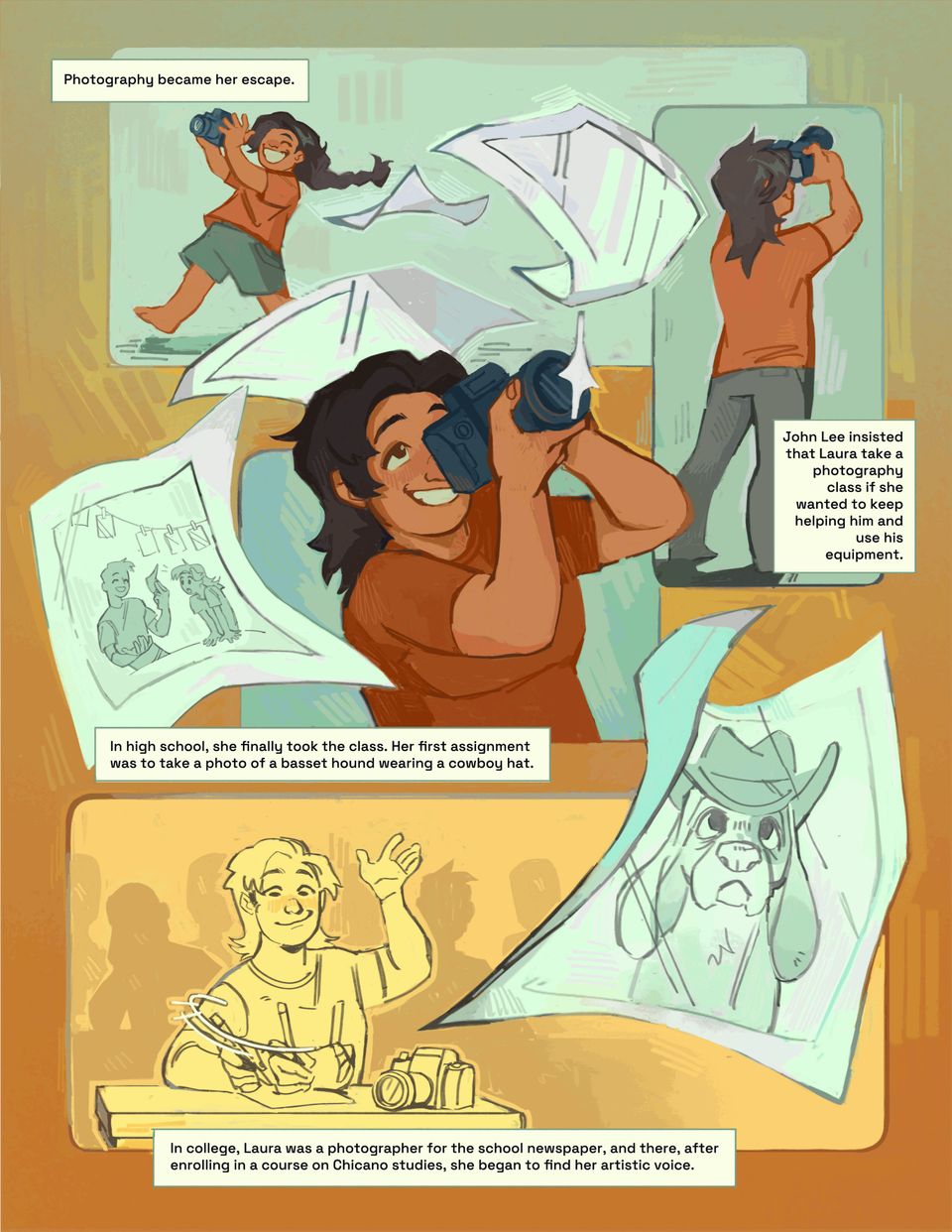
Page 2
Background: This page is broken up into five panels. One at the top left of the page, one to the right side, one in the center and two overlapping at the bottom. There are four light green text boxes with black font. The background of the page is a gradient from muted teal at the top to burnt orange at the bottom.
Panel 1
Laura as a young girl stands at the left of the panel. She has long, dark brown hair in a braid behind her. She is walking to the left edge of the page, holding a black camera in front of her with both hands. She is wearing a burnt orange t-shirt and green shorts and is smiling wide at the camera. Behind her is a light teal backdrop. Text reads: "Photography became her escape."
Panel 2
A teenage version of Laura stands facing away from the viewer. She has dark brown hair cropped into a mullet style and is wearing a burnt-orange T-shirt and gray pants. She is holding a camera up to her face, looking up to the right-hand corner of the page. Text reads: "John Lee insisted that Laura take a photography class if she wanted to keep helping him and use his equipment."
Panel 3
A teenage Laura holds her camera up to her left eye. She has the same dark brown hair cropped into a mullet and is wearing a burnt-orange T-shirt. She is looking through the camera up at the right corner of the page and is smiling widely. A glint of light comes off the lens of her camera. To her left is a piece of light teal photo paper with a monochrome image of a young man and a young girl standing at a table with a clothesline of photos hanging above them. More photos fly up and around the central image of Laura and are light gray and light teal. Text reads: "In high school, she finally took the class. Her first assignment was to take a photo of a basset hound wearing a cowboy hat."
Panel 4
A light teal printed photo sits bent on the right side of the bottom panel. In a monochrome teal, there is an outline of a basset hound looking at the camera wearing a cowboy hat.
Panel 5
Laura as a young woman sits at a desk smiling. She has her left hand raised above her head and is drawing quickly with her right hand on a piece of paper. Her camera sits to the right on the desk. Behind her are the silhouettes of other students sitting at desks. This illustration is monochrome shades of yellow, and the silhouettes behind her get darker as they fade into the light mustard background. Text reads: "In college, Laura was a photographer for the school newspaper, and there, after enrolling in a course on Chicano studies, she began to find her artistic voice."
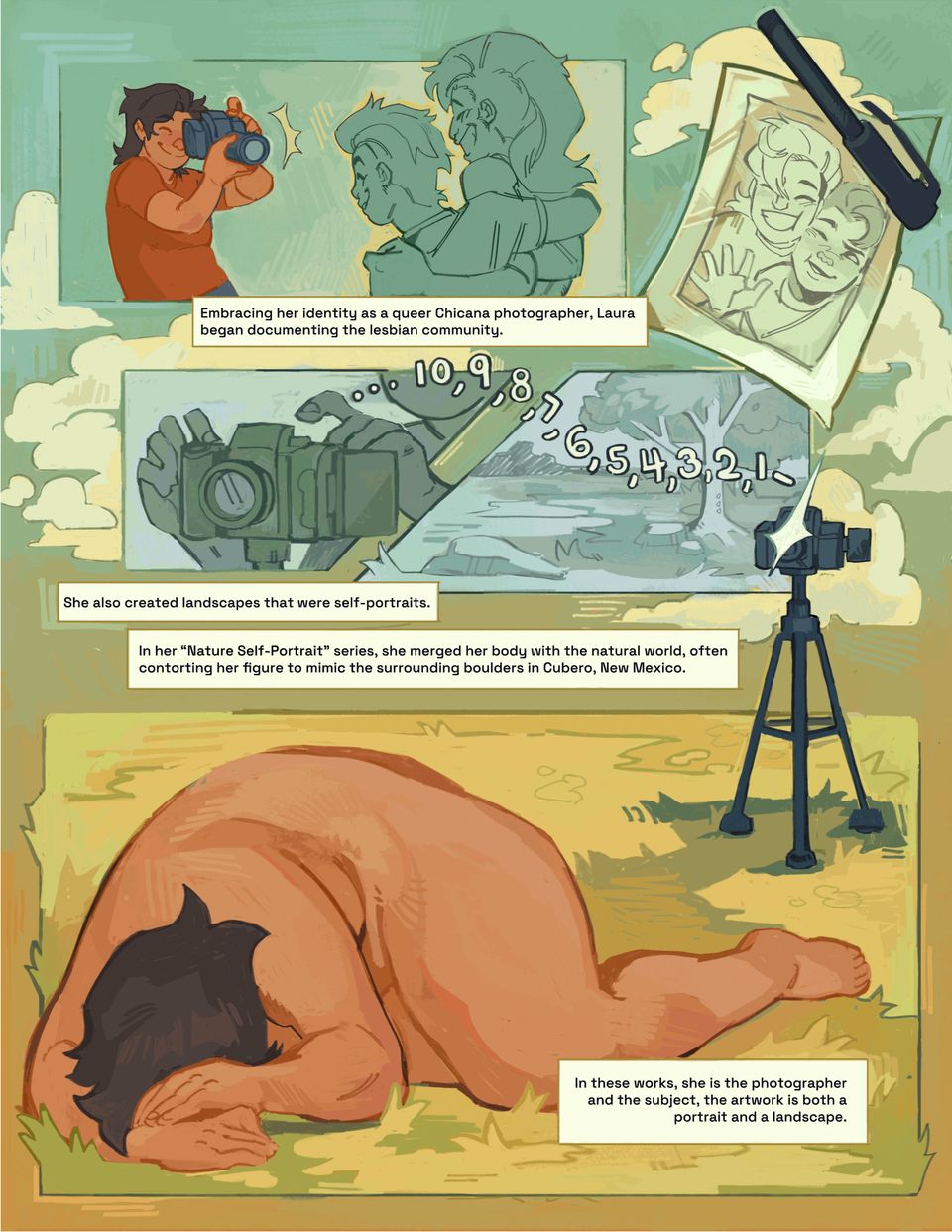
Page 3
Background: This page is divided into three panels. One large panel takes up the whole page, while two smaller panels sit in the upper and middle third of the page, overlapping with the large panel. There are four light green text boxes with black text.
Panel 1
Laura stands in the left of the panel, holding her black camera up to her left eye. She has the same dark mullet and is wearing a burnt orange T-shirt. To the right of the panel are two people embracing each other, smiling at the camera. They are drawn in monochrome teal. The person on the left has short flowy hair and is wearing a t-shirt. The person on the right has a large flowing mohawk and is grinning widely at Laura. Text under the panel reads: "Embracing her identity as a queer Chicana photographer, Laura began documenting the lesbian community." To the right, a piece of monochrome light teal photo paper floats next to the first panel. It shows a sketch of two women smiling and embracing each other, waving at the camera. A black pen lies on top of the photo.
Panel 3
In a strip across the middle of the page, this panel is drawn in only shades of teal. On the left side of the panel a pair of hands adjusts a film camera that is standing on a tripod. Numbers counting down from ten to one flow across the panel. The right side of the panel shows a nature scene, with a body lying on the ground in the left of the image, imitating a rock. Text under the panel reads: "She also created landscapes that were self-portraits. In her 'Nature Self-Portrait' series, she merged her body with the natural world, often contorting her figure to mimic the surrounding boulders in Cubero, New Mexico."
Panel 4
This panel covers the page, with a teal sky taking up the top third of the page. Fluffy cream clouds float in the sky behind the panels that are drawn on top. In the bottom half of the panel, a black camera on a tripod sits in an arid yellow landscape. In the foreground Laura lies face-down, naked, curled into a round shape, covering her head in her hands. The camera flashes, pointed at her. Text in the bottom right reads: "In these works, she is the photographer and the subject, the artwork is both a portrait and a landscape."
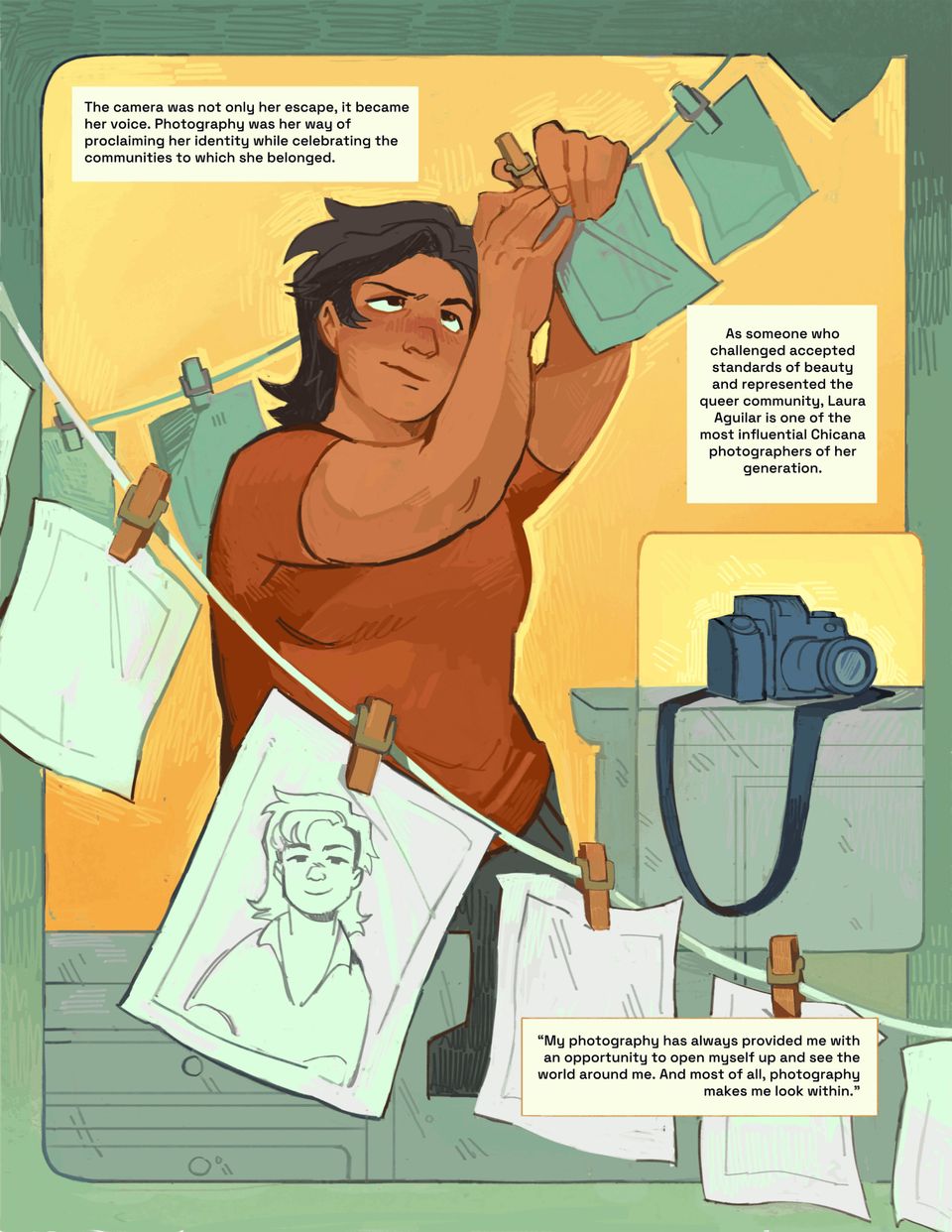
Page 4
Background: This page is all one panel, which sits against a teal background. There are three light green text boxes with black text.
Laura stands in the center of the page, looking up at a clothesline of teal photos. She is wearing a burnt-orange t-shirt and holds her hands up in front of her clipping a photo to the clothesline with a wooden clothespin. There are two clothes lines, one behind her and one in the foreground. The center picture on the clothesline in the foreground is a self-portrait of Laura wearing a collared shirt smiling at the camera. The rest of the images that are hanging are not shown and appear as blank light blue rectangles. On either side of Laura are dark teal desks with drawers. The desk on the right has her camera resting on it, with the black strap hanging off the edge of the table. In the upper left text reads: "The camera was not only her escape, it became her voice. Photography was her way of proclaiming her identity while celebrating the communities to which she belonged." Another text box in the center reads: "As someone who challenged accepted standards of beauty and represented the queer community, Laura Aguilar is one of the most influential Chicana photographers of her generation." A final text box at the bottom of the page reads: "'My photography has always provided me with an opportunity to open myself up and see the world around me. And most of all, photography makes me look within.'"
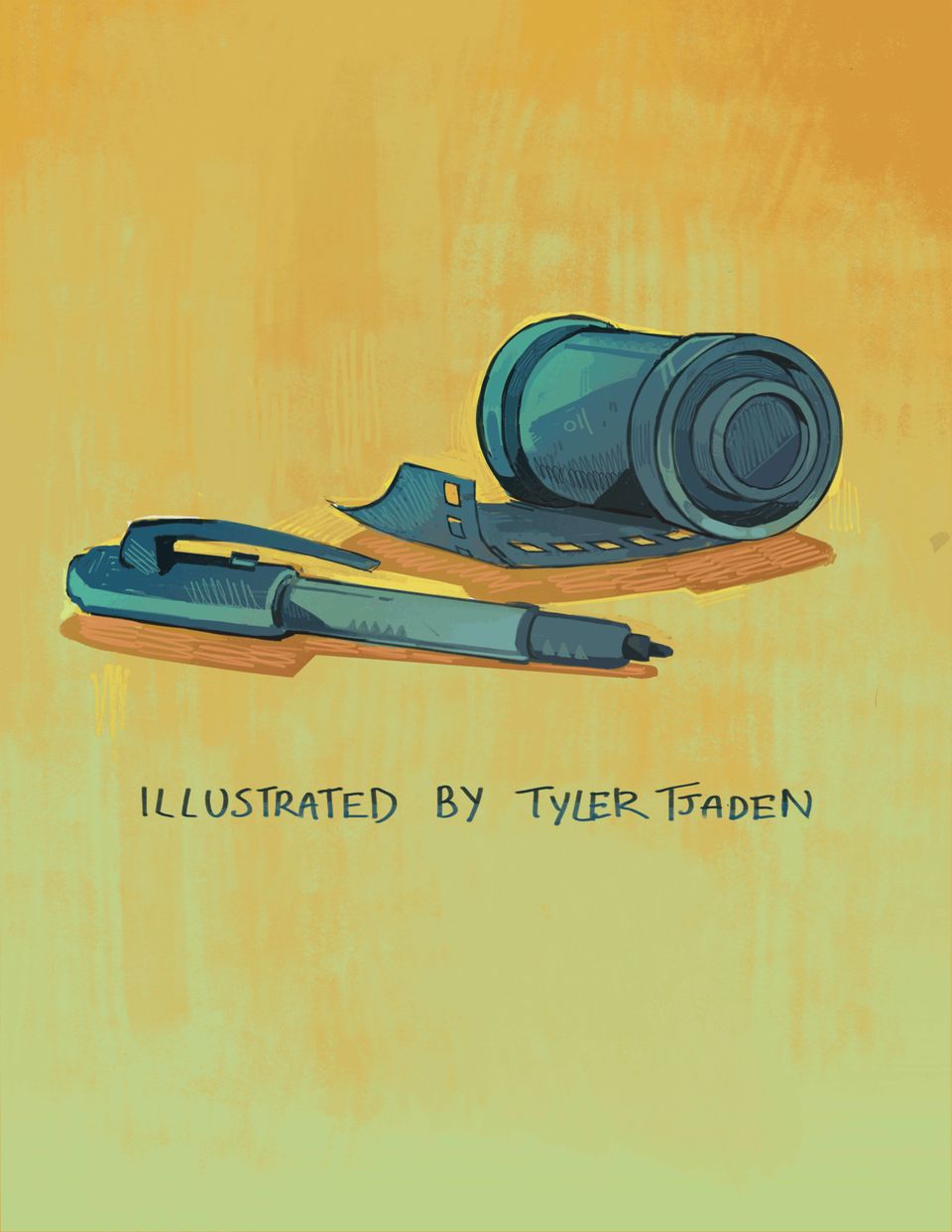
End Page
The background of the page is a streaky gradient that starts with light orange on top and fades into light green on the bottom. In the center of the page is a green and dark blue pen which lies flat with the cap off. Behind it is a roll of green and dark blue film, with the tail of the film curled up in the center of the page. Text below reads: "Illustrated by Tyler Tjaden."














